November 1, 2018 —  The history of agriculture is best described as getting “more for more.” The more land we farmed, the more food we produced. The more water, fertilizers and pesticides we applied, the more bountiful our harvests. While modern farming successfully feeds billions of people, its rapid expansion has also led to biodiversity loss, polluted waterways and rising greenhouse gas emissions. As the world population climbs toward 10 billion people and the impacts of climate change set in, this approach is not sustainable.
The history of agriculture is best described as getting “more for more.” The more land we farmed, the more food we produced. The more water, fertilizers and pesticides we applied, the more bountiful our harvests. While modern farming successfully feeds billions of people, its rapid expansion has also led to biodiversity loss, polluted waterways and rising greenhouse gas emissions. As the world population climbs toward 10 billion people and the impacts of climate change set in, this approach is not sustainable.
“The big advances we need to see in the future, which people frame as ‘sustainable intensification,’ is where we need to get more for less,” says Navin Ramankutty, interim director of the Institute for Resources, Environment and Sustainability at The University of British Columbia.
Debates over the future of food and farming are often framed as a choice between two seemingly diametrical approaches. One, conventional agriculture, aims to produce as much food as possible with vast monocultures dependent on irrigation systems, synthetic fertilizers and pesticides. The other, organic farming, prioritizes sustainability, using natural inputs and processes to make farms more hospitable to nature.
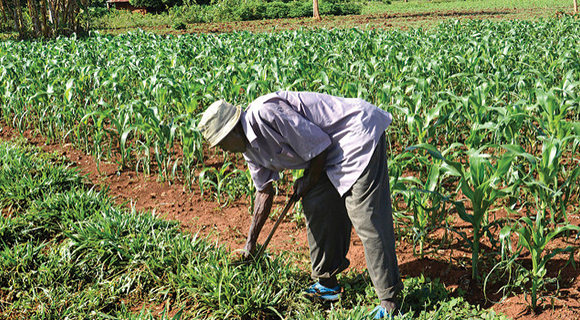
Brachiaria grasses and other forages are being used in western Kenya as part of a “push-pull” approach to pest management and soil fertility improvement developed by the International Centre of Insect Physiology and Ecology (ICIPE). Photo courtesy of CIAT, from Flickr, licensed under CC BY-NC-SA 2.0
An evolving concept called sustainable intensification seeks to bridge this gap by taking the best ideas from both sides and minimizing their weaknesses, such as conventional agriculture’s fertilizer overuse and organic farming’s tendency toward lower yields.
“We just can’t go all conservation agriculture or organic,” explains Vara Prasad, a crop scientist at Kansas State University. “At the same time, we cannot afford to be polluting our environment with the negative impacts that are happening now.”
Sustainable intensification recognizes the need to produce enough food to feed a growing population, but seeks to do so in the most environmentally friendly way possible. In particular, it focuses on increasing yields — the amount of food produced per unit of land — as a way to minimize the need to convert forest and other uncultivated land to farms.
“That first cut makes a big difference, so anything we can do to avoid that is great,” says Ramankutty, in reference to deforestation in Brazil and Indonesia caused by agricultural expansion.

Analysis of 85 integrated pest management projects in Asia and Africa showed that most reduced pesticide use without causing a yield decline. Adapted from Pretty, J., & Bharucha, Z. (2015) Integrated Pest Management for Sustainable Intensification of Agriculture in Asia and Africa. Insects 6:152-182. Click to enlarge.
Environmental sustainability is just as important as increasing production, says Prasad. In addition to preserving wild lands, environmental objectives include reducing greenhouse gas emissions, nitrogen and phosphorus runoff, and pesticide pollution, and protecting freshwater resources. However, sustainable intensification realizes that there is no perfect solution. With so many targets, there are bound to be trade-offs.
Sustainable intensification does not specify particular technologies or practices. Instead, it focuses on desired outcomes: more food on less land, with less of an adverse impact on the environment.
Win-Win Strategies
While the concept is open, scientists studying sustainable intensification point to several evidence-backed strategies and technologies that can increase yields while achieving environmental gains. A recent study published in Nature Sustainability estimates that 163 million farms covering some 453 million hectares (1 billion acres) are practicing some form of sustainable intensification.
One of the most promising strategies is improving crop varieties and livestock breeds. Developing pest- and disease-resistant seeds through traditional breeding or genetic engineering can increase yields and reduce pesticide use. Cultivars suited to local conditions and weather extremes, such as drought and heat, can also help farmers produce more food without degrading ecosystems.
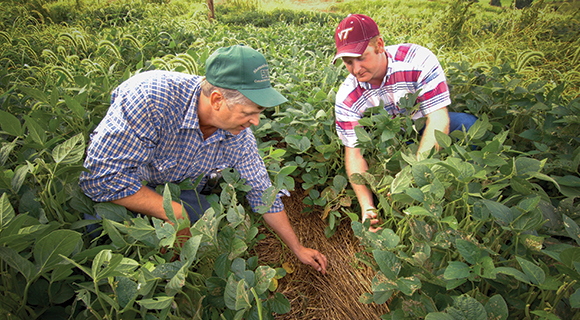
Farmers in Virginia use no-till practices to protect wildlife habitat and water quality in the Chesapeake Bay Watershed. Photo courtesy of USDA, from Flickr, licensed under CC BY 2.0
Efficient use of inputs is a common goal in sustainable intensification practices. Integrated pest management, which employs strategies such as biological controls to combat pests, can protect crops without harming beneficial insects. A 2015 meta-analysis of 85 integrated pest management projects found a “mean yield increase across projects and crops of 41 percent, combined with a decline in pesticide use to 31 percent.” Conservation agriculture practices — such as no-till farming, cover cropping and crop rotations — improve soil quality and reduce weeds, cutting costs and storing carbon underground.

The Sustainable and Resilient Farming Systems Intensification in Eastern Gangetic Plains project, a collaboration of the Australian Centre for International Agricultural Research and the International Maize and Wheat Improvement Center, aims to improve productivity of smallholder agriculture in Nepal. Photo courtesy of IFPRI South Asia, from Flickr, licensed under CC BY-NC-ND 2.0
Growing trees and shrubs on and around crop and pasture land can benefit farmers and local ecosystems, providing habitat to birds and other creatures. Trees on silvopastures protect animals from the hot sun in the summer and cold winds in the winter, and the nutritious grasses beneath them beef up livestock quickly and cheaply. Trees on and around farms can fix nitrogen in the soil, sequester carbon, and reduce runoff and soil erosion.
Technology such as precision farming equipment — which combines detailed data with robots, sensors and imaging to plant seeds and apply water, fertilizers and pesticides in more efficient ways — can increase the productivity of already high-yielding farms while cutting costs on inputs. Among a host of win-win technologies under development are improved weather forecasting tools, which help farmers select optimal planting and harvesting dates, and nitrogen-fixing liquid probiotics, which could replace at least some synthetic fertilizers.
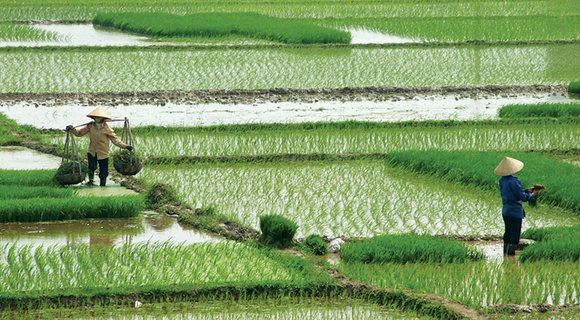
Intensive cultivation boosts yields from rice paddies in Hai Duong, Vietnam. Photo courtesy of Eric Baker, from Flickr, licensed under CC BY-NC-SA 2.0
Another strategy involves growing crops on fallow land and planting and harvesting more often on existing cropland. Doing so increases the productivity of land already cleared for crops, reducing the need to convert forests and other natural habitats.
“There’s no shortage of technical tools, technical opportunities that people can use to both increase crop productivity and reduce their environmental impact,” says Tim Searchinger, a professor at Princeton and a researcher at the World Resources Institute. “It’s not a scientific problem, it’s a doing problem.”
Location and Context
In some areas, such as sub-Saharan Africa, yields are very low due primarily to a lack of water and nutrients in the soil. This low baseline means that the tools of modern farming offer a huge opportunity to get more food out of existing farmland. However, if this intensification is to be sustainable, it will be crucial to pair this access with programs that educate farmers about best practices to avoid waste and pollution, Prasad says.
“One thing that often gets forgotten is that fertilizer application isn’t inherently bad,” explains Michael Clark, a postdoctoral researcher at the University of Oxford. “When you start applying too much is when it becomes an issue.”
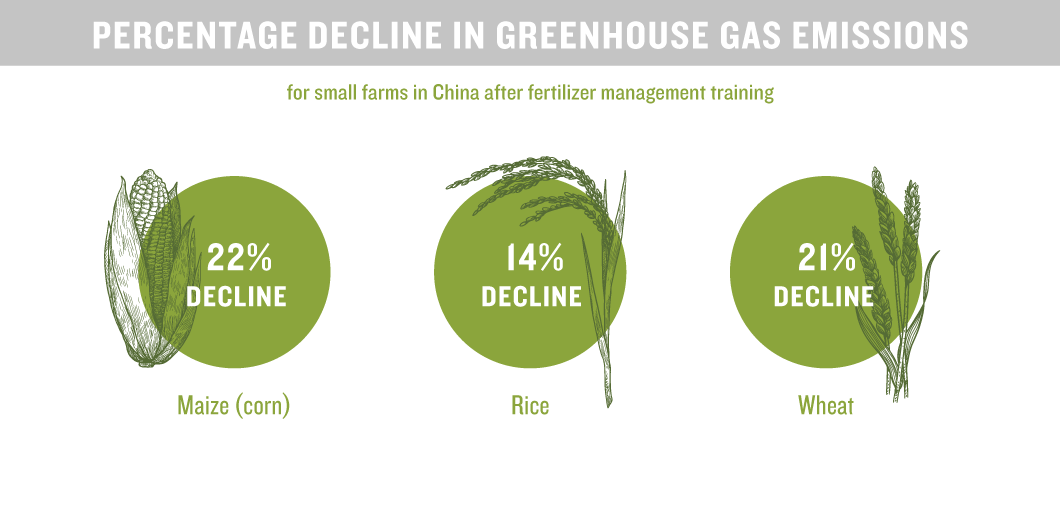
Small farms in China produced fewer greenhouse gas emissions after farmers participated in training programs focusing on fertilizer management. Adapted from Cui, Z., et al. Nature http://dx.doi.org/10.1038/nature25785 (2018)
China is doing its part to combat fertilizer overuse by funding agricultural scientists to live in villages, where they teach farmers when and how to apply fertilizer more effectively. These initiatives helped over 20 million smallholder farmers increase yields of corn, rice and wheat ten percent while reducing fertilizer use 15 percent, significantly cutting greenhouse gas emissions in the process.
As new regions adopt water irrigation systems to boost crop yields, farmers with first access tend to overuse the precious resource, leaving little for late adopters. Local regulations and water user groups can help farmers use water in more efficient, equitable and sustainable ways.
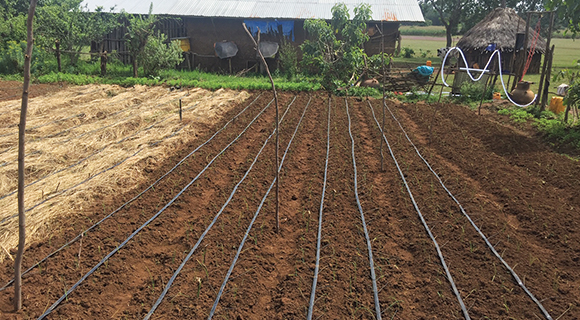
Farmers in Ethiopia are using local grass mulch and drip irrigation to sustainably intensify their yields. Photo courtesy of the Sustainable Intensification Innovation Lab
In addition to agricultural technologies and practices, building up social and economic structures and institutions is an important part of sustainable intensification. Prasad says that investing in farmer field schools and developing extension programs in developing countries is necessary to help farmers implement sustainable practices and technologies.
Sustainable Food System
Although sustainable intensification is an important part of making agriculture more sustainable, it can’t do the job alone. If we try to produce enough food to meet current projections without expanding cropland, we would need to increase crop yields 11 percent more from 2006 to 2050 than we did from 1962 to 2006 — a tall order given that past gains are largely attributed to added inputs. Clark says that a truly sustainable food system must also address food waste and overeating, as well as shift diets away from meat and dairy, which account for an outsize share of agriculture’s environmental footprint.
In addition, in what’s known as Jevons paradox, efficiency gains can incentivize farmers to produce more, which can lead to additional land clearing. In order to reap the full benefits of sustainable intensification, we’ll have to do a better job of making sure that natural areas are off limits to agricultural expansion.
Although challenges remain, the math of sustainable intensification is simple: The more food we produce on the least amount of land with the least environmental impact, the better off humans — and nature — will be. ![]()
Related Posts
Ensia shares solutions-focused stories free of charge through our online magazine and partner media. That means audiences around the world have ready access to stories that can — and do — help them shape a better future. If you value our work, please show your support today.
Yes, I'll support Ensia!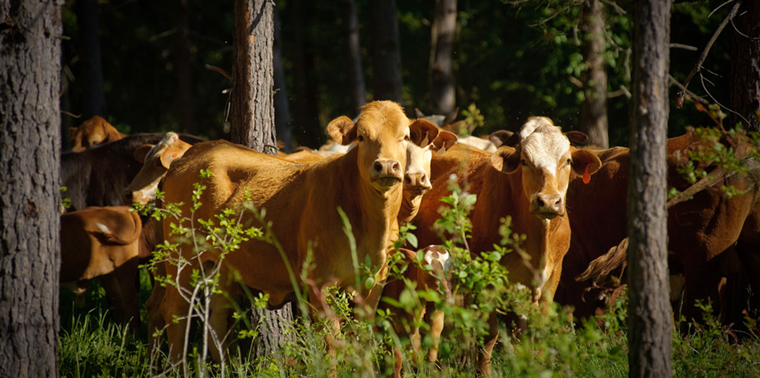





https://biofortified.org/2019/08/food-without-photosynthesis/
https://www.frontiersin.org/articles/10.3389/fsufs.2019.00032/full
Obviously crop rotation, organic mulching, cover crops, green manure, all included in any sustainable future. But meanwhile our oceans will be void of fish, by 2030 at this rate